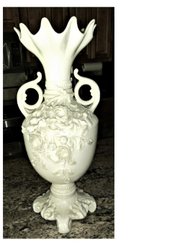DEAR HELAINE AND JOE: I am curious to see if you are able to give me a valuation on the pictured Belleek vase. I bought it at auction around 1970. It is approximately 13 inches tall and has no chips or cracks. The trademark has mostly worn off, but originally it was black.
-- D.J.
DEAR D.J.: Some sources say that the roots of Irish Belleek porcelain -- American Belleek porcelain exists as well -- date to the Irish potato famine of 1845-49.
When John Caldwell Bloomfield inherited his father's estate in Belleek County Fermanagh, Northern Ireland, he wanted to find a way to provide work for his tenants, who had just suffered through the famine. He found his lands were rich in minerals and clay and began trying to establish a pottery in conjunction with London architect Robert Williams Armstrong and Dublin merchant David McBirney.
It took them until 1863 to produce marketable quantities of Parian (think white marble) porcelain, which was thinly potted and covered with a slightly iridescent glaze. The wares were shown at the 1865 Dublin Exposition and are still in production.
The first mark, featuring a hound and a harp with a castle tower and shamrocks, was used from 1863 to 1890. The second black mark was used from 1891 until 1926, including a banner at the bottom with Co Fermanagh, Ireland written in it. The third black mark was essentially the same as the second except for a circular device below the banner.
The third black mark was in use between 1926 and 1946, the time period in which the vase in today's question was made. We came to this conclusion because we see vestiges of the circular device below the faint remnants of the banner.
It is unusual to see obliterated marks on Irish Belleek, but we feel this one might not have been properly affixed in the first place. In any event, the form of the vase and the applied decorations are unquestionably Irish Belleek. We are a bit surprised at D.J.'s assertion that there are "no chips or cracks" because the raised floral decoration almost always has some losses, and we assume the problems can be overlooked because they are very light and to be expected.
After the three black marks, Belleek porcelain was marked with a variety of colors. First, there were green marks followed by a gold mark. In 2000 a plainly marked millennium black mark was used, but currently the mark is brown.
The color of the mark on Irish Belleek makes all the difference in the world to collectors. The black marked pieces are often highly regarded, with first black mark examples demanding something of a premium. Collectors can be a bit dismissive of examples with other colored marks.
Collectors tend to prefer pieces with elaborate applied floral designs and baskets woven from spaghetti-like strands of porcelain and then decorated with applied florals. Tea wares in the "Neptune" pattern are also desired. Irish Belleek prices have declined since D.J. bought the piece, which would now sell at auction for about $70 with a retail price from around $110 to $135.
Helaine Fendelman and Joe Rosson have written books on antiques. Do you have an item you'd like to know more about? Contact them at Joe Rosson, 2504 Seymour Ave., Knoxville, Tenn. 37917, or email them at treasures@knology.net. If you'd like your question to be considered for their column, please include a high-resolution photo of the subject, which must be in focus, with your inquiry.
HomeStyle on 11/10/2018
